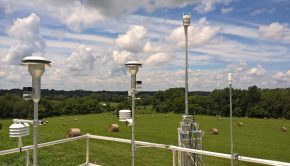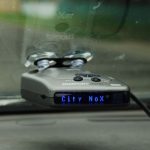The Big Picture: Microbiologist Hamza Mbareche Reviews Advances in Air Quality Monitoring
Measuring the quality of the air we breathe has come a long way since the Ionic Breeze Air Purifier graced the glossy pages of the Sharper Image catalog decades ago.
Technology has rapidly evolved to fill the need for precise detection of airborne pathogens and particles. Homeowners and businesses alike want to know whether microbes, fungi and cancer-causing substances such as asbestos are suspended in living spaces, and at what concentration.
In reality, it didn’t take much new technology to surpass the low bar set by home appliances such as the Ionic Breeze. In 2003 Consumer Reports reviewed the model and declared it was essentially a softly-whirring gadget that did nothing to remove harmful particles from the air. When Sharper Image complained, Consumer Reports conducted additional tests, with the same result. When Sharper Image sued, the retailer lost the case and in 2008 filed for Chapter 11 bankruptcy protection.
On the core issue of whether the Ionic Breeze really worked, years of claims, counterclaims and litigation had finally cleared the air.
Fast forward to 2022. Customers are now able to choose from a wide array of air quality monitoring and purification systems, including reference-grade FRM/FEM monitors, mobile air quality sensors, stationary low-cost sensors, and even satellite monitoring technology.
These options measure air quality in different ways, and often provide different data outputs. According to Hamza Mbareche, an acknowledged expert in air sampling and molecular biology, the choice of the most appropriate monitoring technology can make the difference between a healthy environment and an atmosphere that is risky for people.
A postdoctoral researcher of airborne microorganisms, the microbiome, genomics and bioinformatics, Toronto-based Hamza Mbareche has been ranked 22nd in a list of more than 7,000 researchers for his proven expertise in air microbiology over the last five years.
“Air quality monitoring using FRM and FEM equipment developed largely as a result of U.S. government mandates,” he explains. “In fact, FRM is an abbreviation for federal reference method and FEM stands for federal equivalent method, so you have the genesis of the technology right there in the name.”
A key reason both the U.S. and Canadian governments got involved in the maturation and application of these technologies is that they needed ways to measure air quality in cases where atmospheric data are used to develop policy and measure compliance with regulatory standards.
This type of monitoring equipment is extremely precise — and expensive. A single monitor may cost as much as $40,000 USD. On top of that, the equipment requires lots of TLC from highly trained technicians. Because the monitors need specific types of environments and infrastructure, they are harder to deploy and often impractical when it comes to measuring air quality in small spaces.
That’s where mobile air quality monitoring comes in. Mobile monitors are light enough to be mounted on cars, and much less expensive. This sometimes comes at the expense of accuracy. Stationary low-cost sensors that are not considered mobile are equally attractive options, but also tend to fall short of the FRM/FEM gold standard.
The most dramatic advance — featuring the heaviest and most costly option of all — relies on satellites. NASA’s Moderate Resolution Imaging Spectroradiometer (MODIS) is one notable example of how a stratospheric view can identify and quantify large-scale trends in air quality.
“Satellite air quality monitoring gives us an amazing window into what is happening in our atmosphere,” says Mbareche. “Space-based instruments can quantify aerosol optical depth by measuring solar radiation at the surface and at the atmosphere’s edge, while observing how sunlight is scattered by ambient particles. This can all be cross-tabulated with on-ground measurements to create a comprehensive picture of atmospheric health and trends.”
NASA also includes a TROPOspheric Monitoring Instrument (TROPOMI) on its air monitoring satellites. It measures the intensity of reflected sunlight at various wavelengths and gauges the absorption of atmospheric trace gasses. This quantifies the amount of ozone, nitrogen dioxide, sulfur dioxide, and even formaldehyde in the atmosphere.
“These leading-edge satellites can cover our whole planet in one day,” marvels Mbareche. “It gives us a complete picture of what is really going on in our world — and the ways in which we are responsible for air quality degradation.”













